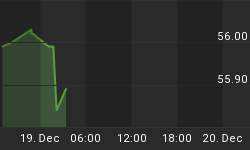While this is not the last thought we will have this year, it is the last thoughts on Gold we will send to you in 2010. With a new year in about to about two weeks, perhaps it is time to clear our heads. We will soon be given a fresh calendar on which to record the unfolding of events. Out heads should be also ready to receive that newness for yesterday will not be repeated.
Thus far 2010 has unfolded about at the center of, rather than the fringe of, the thinking that had existed a year ago. U.S. dollar did not vaporize. $Gold is still well below $10,000. Silver is still well below the $100 fantasy of the delusional. The Euro is still with us, and will be with us at the end of 2011, and 2013, and 2050. Bets to the contrary are foolish.

As the above chart portrays, the U.S. dollar appears to have put in an important bottom. That bottom roughly coincided with the U.S. election which essentially ended the reign of financial terror by the Obama Regime. While financial sanity has yet to develop in the spending habits of the U.S. government, tendency for trend to become more negative has been halted, for the time. Removal of the minions of the current U.S. regime was the first tiny step toward resolving the insolvency of the U.S. Such is enough reason for at least an intermediate bottom in the U.S. dollar.
U.S. electorate has moved to remove many of the more dangerous of the financially irresponsible in U.S. Congress, though many still remain. Message from voters in an election representing the greatest political structural break since 1932 should be heeded. To presume that this shift in the political structure will tolerate a Federal Reserve running amok for the third time in a decade may be naive. Bernanke's gang of Keynesian ideologues and their policies of repetitive asset bubbles are not likely to be tolerated. We suspect that by this time next year Bernanke will be pursuing other opportunities.
That all said, the U.S. dollar, as shown in the above chart, is correcting an over bought condition. As that is accomplished, the basis for a further advance in the dollar's value will be created. We note in that graph the similarities to the previous bottoming process that led to a substantial rally. In such an environment, $Gold is not likely to advance as many emotional forecasts might suggest.

Part of the reason for this view is the above chart of 10 year U.S. Treasury rates. In it we can observe that the markets have determined the policies of the Bernanke Gang are unacceptable. These rates have risen in an unprecedented fashion. With the Federal Reserve monetizing the Obama Deficit, the price of bonds should be rising and interest rates falling. Rather, as interest rates on these bonds are rising, we know that bond prices are falling. Markets are often more powerful than governments.
This interest rate action is supportive of the U.S. dollar's value. By definition then, higher rates are also a negative for value of $Gold. When market conditions are negative for the value of $Gold and the media is filled with fantasy forecasts, watching rather than buying is the prudent course of action. Those forecasting unrealistic prices for $Gold and $100 Silver will not cover your losses.
That all said, in every market are opportunities for someone. One of those building opportunities is with Canadian $Gold. Over valued Loonie is depressing the price of CN$Gold. Given the level of risk building in the Canadian economy and the extremely over valued Loonie, Canadian-based investors may want to begin again to average into the Gold market.
Risk in the Canadian economy is high, and we may be observing a mini-Ireland being created. For this we read from bloomberg.com, 14 December,
"Canada's top economic officials yesterday urged households to be wary of taking on too much debt after data showed the indebtedness of Canadians surpassed U.S. levels for the first time in 12 years."
"Bank of Canada Governor Mark Carney, Finance Minister Jim Flaherty and Prime Minister Stephen Harper said in separate public appearances that they are concerned about rising debt. The ratio of household debt to disposable income in Canada was 1.48 in the third quarter according to Statistics Canada, exceeding the U.S. level of 1.47." [Emphasis added.]
In any event, we wish you all the best in the new year. Remember, history is guidebook, not a plug and play software template.
GOLD THOUGHTS come from Ned W. Schmidt,CFA,CEBS as part of a joyous mission that has saved a multitude of investors from the financial abyss of paper assets. He is publisher of The Value View Gold Report, monthly, and Trading Thoughts, about weekly. To receive these reports, go to: www.valueviewgoldreport.com
















